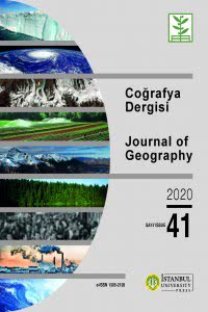CORINE Sistemine Göre Kars İlinde Arazi Örtüsü/Arazi Kullanımı, Değişimi ve Projeksiyonu
Kars, Arazi Örtüsü, Arazi Kullanımı, CORINE
Land Cover/Land Use, Change, and Projection in the Kars Province according to the CORINE System
Kars, Land Cover, Land Use, CORINE,
___
Atalay, İ. (2008). Ekosistem Ekolojisi ve Coğrafyası. Çevre ve Orman Bakanlığı Yayınları. İzmir. google scholarAtalay, İ., & Mortan, K. (2003). Türkiye Bölgeler Coğrafyası (İkinci baskı). İnkılâp Kitabevi, İstanbul. google scholar
Clark Labs, (2018). About Clark Labs. https://clarklabs.org/ adresinden 6 Mart 2020 tarihinde edinilmiştir. google scholar
Comber, A., Fisher, P., & Wadsworth, R. (2005). What is land cover?. Environment and Planning B: Planning and Design, 32(2), 199209. google scholar
COPERNICUS, CORINE (1990). https://land.copernicus. eu/pan-european/CORINE-land-cover adresinden 18 Nisan 2020 tarihinde edinilmiştir. google scholar
COPERNICUS, CORINE (2018). https://land.copernicus. eu/pan-european/CORINE-land-cover, adresinden 15 Nisan 2020 tarihinde edinilmiştir. google scholar
Çivi, A., Akgündüz, E., Kalaycı, K., İnan, Ç., Sarıca, E., & Toru, E. (2009). CORINE (Coordination of Information on the Environment) projesi. TMMOB Coğrafi Bilgi Sistemleri Kongresi, 200, 02-06. google scholar
Demir, M., (2013). Kars Kent Coğrafyası. Atatürk Üniversitesi Sosyal Bilimler Enstitüsü (Yayımlanmamış Doktora Tezi), Erzurum, google scholar
Demir, M. (2016). Kars İlinde Büyük ve Küçükbaş Hayvancılık. Eastern Geographical Review, 20(35). google scholar
Demir, M. (2015). Kars İlinin Nüfus Gelişimi Ve Başlıca Demografik Özellikleri. Doğu Coğrafya Dergisi, 20(34), 127-156. google scholar
Demir, M. (2018). Doğal ve Beşeri Çevre Özellikleri Bakımından Kağızman İlçe Merkezi. Pegem Akademi. Ankara. google scholar
DMİGM (2016). Ankara: Devlet Meteoroloji İşleri Genel Müdürlüğü. google scholar
Dzieszko, P. (2014). Land-cover modelling using corine land cover data and multi-layer perceptron. Quaestiones Geographicae, 33(1), 5-22. google scholar
Eastman, J. R. (2009). IDRISI Guide to GIS and Image Processing Accessed in IDRISI Selva 17. Clark University, Worcester, 182185. google scholar
Eastman J. R. (2012). IDRISI Guide to GIS and Image Processing Accessed in IDRISI Selva 17. Clark University, Worcester, 324 p. google scholar
European Environment Agency. (2020). https://www.eea.europa.eu/ İnternet adresinden 10 Nisan 2020 tarihinde edinilmiştir. google scholar
Fisher, P. F., Comber, A. J., & Wadsworth, R. (2005). Land use and land cover: contradiction or complement. Re-presenting GIS, 85-98. google scholar
HGK. (2014). www.hgk.msb.gov.tr/images/urun/il_ilce_alanlari.pdf, adresinden 10.Nisan.2020 tarihinde edinilmiştir. google scholar
MTA. (2008). Kars İli Genel Jeolojisi, Doğu Anadolu Bölge Müdürlüğü, Van Ott, L., Larson R. F., Mendenhall, W. (1983). Statistics: A Tool for the Social Sciences. Boston: Duxbury Press. google scholar
Pontius, G. R. (2000). Quantification error versus location error in comparison of categorical maps. Photogrammetric Engineering, Remote Sensing, 66(8), 1011-1016. google scholar
Pontius, G. R., & Malanson, J. (2005). Comparison of the structure and accuracy of two land change models. International Journal of Geographical Information Science, 19(2), 243-265. google scholar
Rumelhart D., Hinton G., Williams R. (1986). Learning internal representations by error propagation. In: D.E. Rumelhart, J.L. McClelland (eds), Parallel distributed processing: explorations in the microstructures of cognition (Vol. 1; pp. 318-362). Cambridge: MIT Press google scholar
Sang, L., Zhang, C., Yang, J., Zhu, D., & Yun, W. (2011). Simulation of land use spatial pattern of towns and villages based on CA-Markov model. Mathematical and Computer Modelling, 54(3-4), 938-943. google scholar
Subedi, P., Subedi, K., & Thapa, B. (2013). Application of a hybrid cellular automaton-Markov (CA-Markov) model in land-use change prediction: a case study of Saddle Creek Drainage Basin, Florida. Applied Ecology and Environmental Sciences, 1(6), 126132. google scholar
TUİK. (2021). https://data.tuik.gov.tr/Kategori/GetKategori?p=Nufus-ve-Demografi-109 adresinden 10 Şubat 2017 tarihinde edinilmiştir. google scholar
Tarım ve Orman Bakanlığı. (2020). https://CORINE.tarimorman.gov.tr/ CORINEportal/amac.html adresinden 10 Nisan 2020 tarihinde edinilmiştir. google scholar
Turner, B. L., & Meyer, W. B. (1994). Global land-use and land-cover change: an overview. Changes in land use and land cover: a global perspective, 4(3). google scholar
- Yayın Aralığı: Yılda 2 Sayı
- Başlangıç: 1985
- Yayıncı: İstanbul Üniversitesi
Yerleşme Coğrafyası Açısından Bir İnceleme: Yalova Şehri
Emeğin Etnikleşmesi ve Feminizasyonu: Çay Tarımında Kadın ve Gürcü Emeği
Muhammet ÖKSÜZ, Ertuğrul Murat ÖZGÜR
Ahmet KARAKOÇ, Murat KARABULUT
Türkiye’de Doğurganlık, Göç ve Mekânsal Etkileşim: Seçicilik Hipotezi Kapsamında Bir Analiz
Mersin, Tarsus ve Adana Hattındaki Şehirsel Büyümenin Mekânsal Etkileri
Selin YILDIZ GÖRENTAŞ, Sevil SARGIN
CORINE Sistemine Göre Kars İlinde Arazi Örtüsü/Arazi Kullanımı, Değişimi ve Projeksiyonu
Modern Coğrafi Düşüncede Mekân ve Yer Kavramlarının Teorik Temelleri Üzerine Bir Değerlendirme
